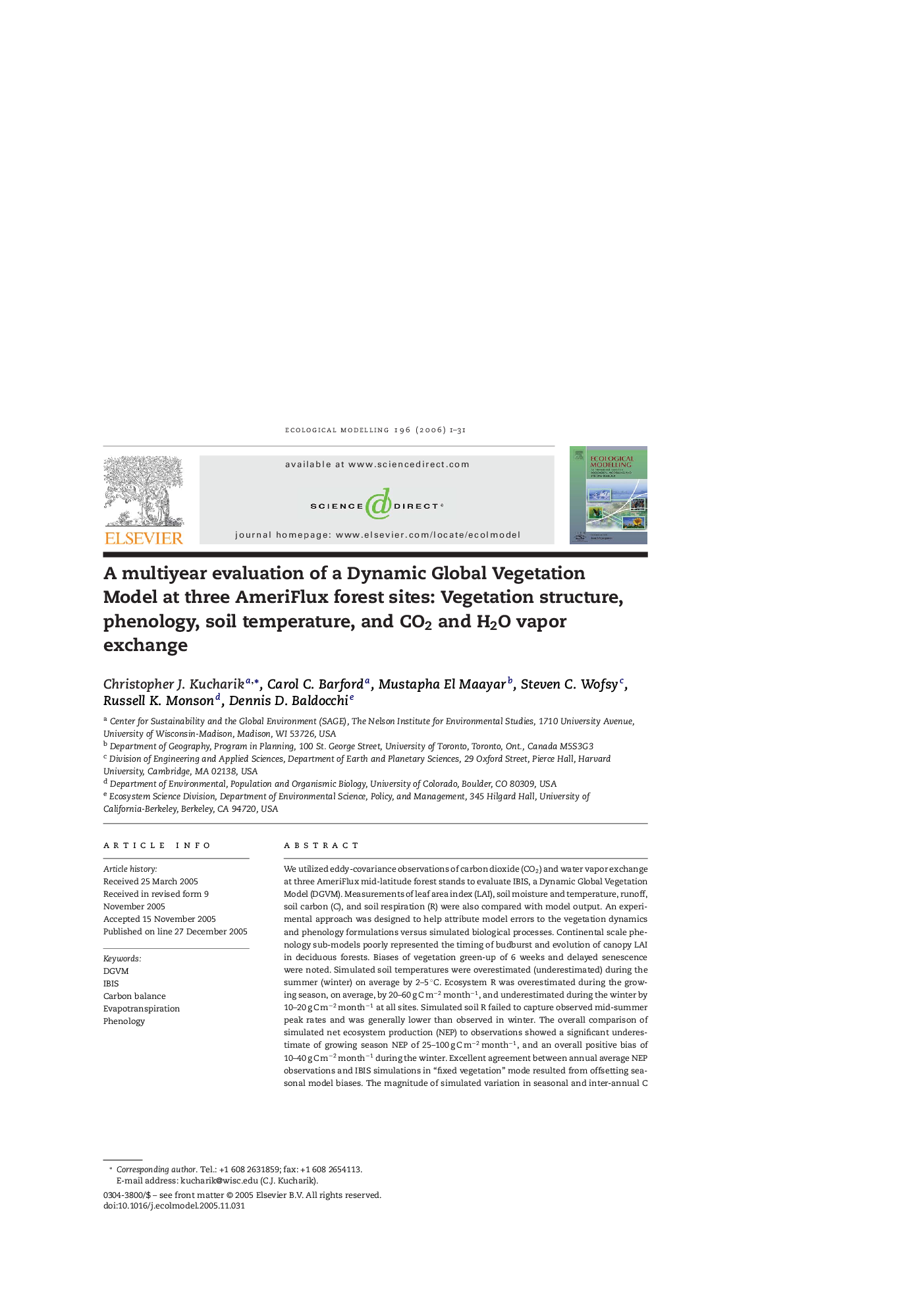| کد مقاله | کد نشریه | سال انتشار | مقاله انگلیسی | نسخه تمام متن |
|---|---|---|---|---|
| 4379029 | 1617562 | 2006 | 31 صفحه PDF | دانلود رایگان |
عنوان انگلیسی مقاله ISI
A multiyear evaluation of a Dynamic Global Vegetation Model at three AmeriFlux forest sites: Vegetation structure, phenology, soil temperature, and CO2 and H2O vapor exchange
دانلود مقاله + سفارش ترجمه
دانلود مقاله ISI انگلیسی
رایگان برای ایرانیان
موضوعات مرتبط
علوم زیستی و بیوفناوری
علوم کشاورزی و بیولوژیک
بوم شناسی، تکامل، رفتار و سامانه شناسی
پیش نمایش صفحه اول مقاله

چکیده انگلیسی
We utilized eddy-covariance observations of carbon dioxide (CO2) and water vapor exchange at three AmeriFlux mid-latitude forest stands to evaluate IBIS, a Dynamic Global Vegetation Model (DGVM). Measurements of leaf area index (LAI), soil moisture and temperature, runoff, soil carbon (C), and soil respiration (R) were also compared with model output. An experimental approach was designed to help attribute model errors to the vegetation dynamics and phenology formulations versus simulated biological processes. Continental scale phenology sub-models poorly represented the timing of budburst and evolution of canopy LAI in deciduous forests. Biases of vegetation green-up of 6 weeks and delayed senescence were noted. Simulated soil temperatures were overestimated (underestimated) during the summer (winter) on average by 2-5 °C. Ecosystem R was overestimated during the growing season, on average, by 20-60 g C mâ2 monthâ1, and underestimated during the winter by 10-20 g C mâ2 monthâ1 at all sites. Simulated soil R failed to capture observed mid-summer peak rates and was generally lower than observed in winter. The overall comparison of simulated net ecosystem production (NEP) to observations showed a significant underestimate of growing season NEP of 25-100 g C mâ2 monthâ1, and an overall positive bias of 10-40 g C mâ2 monthâ1 during the winter. Excellent agreement between annual average NEP observations and IBIS simulations in “fixed vegetation” mode resulted from offsetting seasonal model biases. The magnitude of simulated variation in seasonal and inter-annual C exchange was generally dampened with respect to observations. The parameterization, and in some cases the formulations (e.g., ecosystem R and phenology) limited model capacity to capture the seasonal fluctuations of C and water exchange. Model parameterizations and formulations were originally constrained and generalized for application to a wide range of global climate and soil conditions and plant functional types (PFTs), likely contributing to model biases. This problem potentially applies to other DGVMs and biosphere models, and will likely become increasingly relevant if investigators apply their models at higher spatial resolution. We suggest that revisions to DGVMs should focus on advancing the capabilities of current phenology formulations to account for photoperiod, soil moisture and frost in addition to temperature. Model representations of PFTs and formulations of ecosystem R need to be rethought, particularly with respect to use of Q10 temperature functions as modifiers. Surface energy balance, C allocation, soil R, and plant response to nutrient stress deserve attention as well.
ناشر
Database: Elsevier - ScienceDirect (ساینس دایرکت)
Journal: Ecological Modelling - Volume 196, Issues 1â2, 10 July 2006, Pages 1-31
Journal: Ecological Modelling - Volume 196, Issues 1â2, 10 July 2006, Pages 1-31
نویسندگان
Christopher J. Kucharik, Carol C. Barford, Mustapha El Maayar, Steven C. Wofsy, Russell K. Monson, Dennis D. Baldocchi,